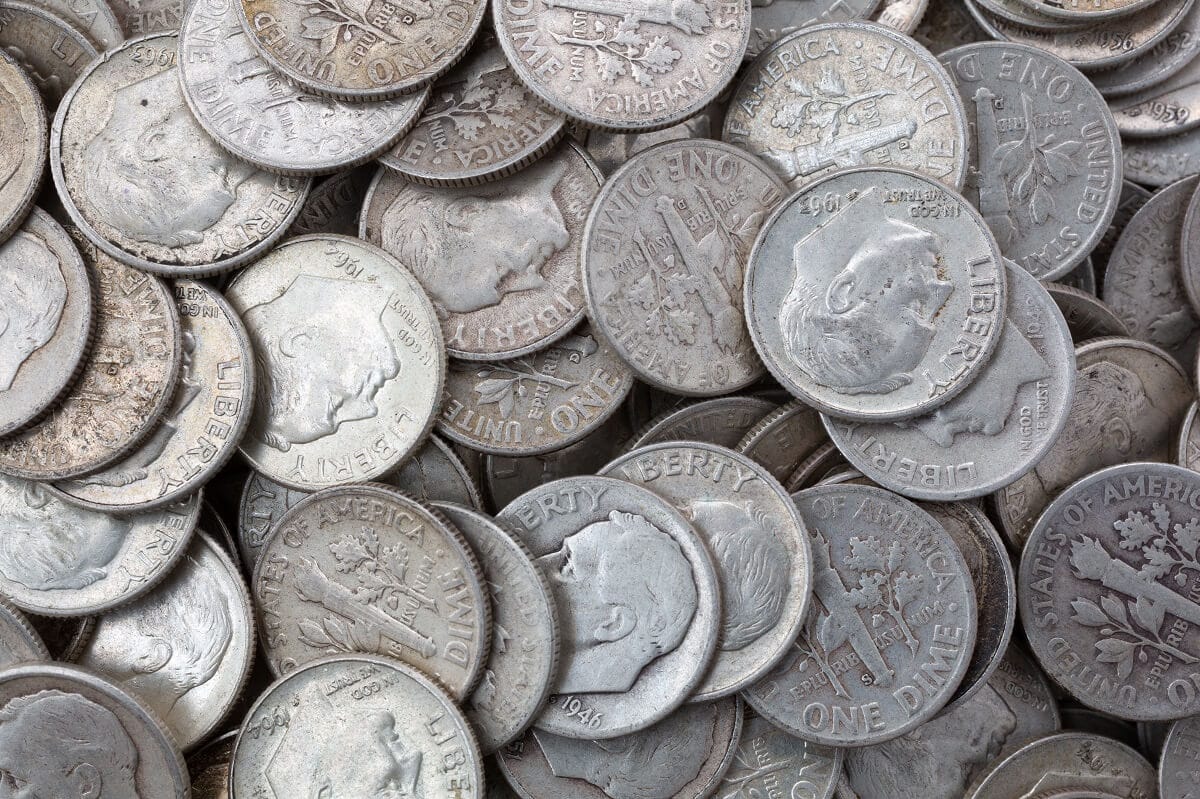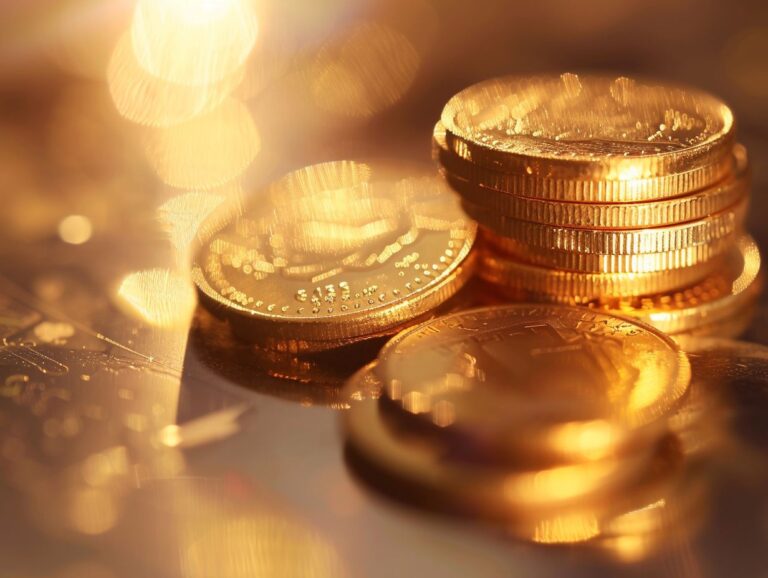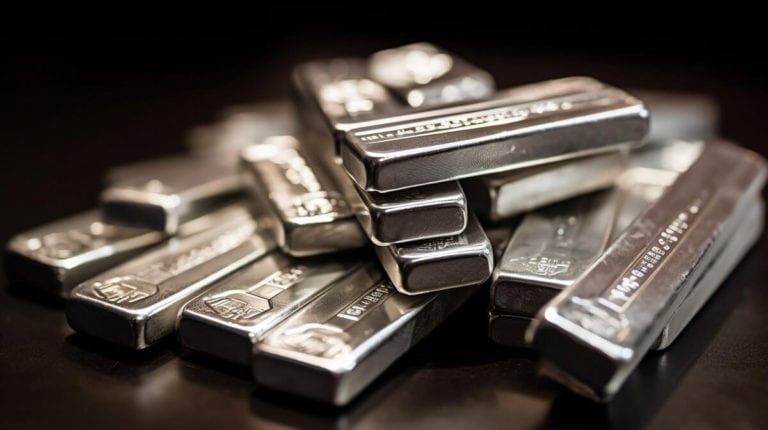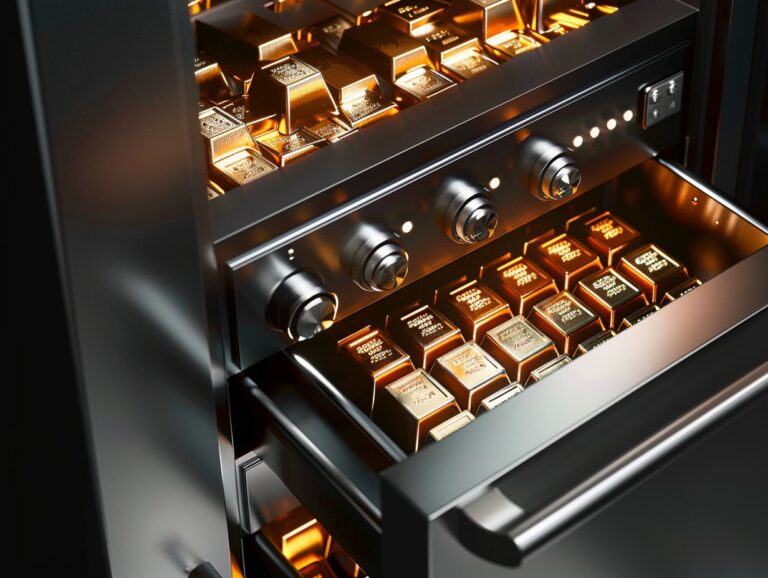- Our content is independently written and reviewed by trusted reviewers & fact-checkers.
- Your information is never sold. We can earn money by connecting you with top Gold IRA Companies. Learn how our reviews work.
- Want to learn more? Meet our authors and explore our editorial policy.

The humble dime, often overlooked in favor of more substantial coins, has a fascinating tale. One of the most intriguing aspects of this coin’s narrative is the silver dime.
This coin carries not just the physical heft of precious metal but also a rich legacy of American history and economic fluctuations.
But beyond its lustrous gleam and storied past, have you ever paused to wonder about its weight?
If so, and you’re looking for some answers, read on to find out how much a silver dime weighs.
Table of Contents
The History of the Silver Dime: A Brief Overview
The “dime,” as a term and as a coin, holds a rich and fascinating history. Its name finds its origins in the French language, specifically from the word “disme,” meaning “tenth part.”
This name was chosen as an indicator of its value – the dime being one-tenth of a dollar, an integral part of the decimal currency system established in the United States following the Coinage Act of 1792.
Silver dimes have long been the subject of intrigue and admiration, chiefly among numismatists and precious metal investors.
From 1837 to 1964, these coins were crafted from an alloy of 90% silver and 10% copper. This high silver content gives these coins both their distinctive appearance and their historical significance.
The design of the dime has changed over time, reflecting the social, political, and economic changes in the United States.
Weight of a Silver Dime
A silver dime from the United States, specifically those minted between 1837 to 1964, typically weighs 2.5 grams.
After 1965, the composition of dimes in the United States changed to a copper-nickel clad, altering the weight slightly to 2.268 grams.
Types of Silver Dimes
The United States Mint has produced several types of silver dimes over the years. Each type carries unique characteristics, historical significance, and aesthetic designs that are representative of its time.
Draped Bust Dimes (1796–1807)
Designed by Robert Scot, these dimes feature a portrait of Lady Liberty with flowing hair and a draped bust, which gives the coin its name. The reverse side shows a small eagle (1796–1797) or a heraldic eagle (1798–1807). These dimes are composed of 89.24% silver and 10.76% copper.
Capped Bust Dimes (1809–1837)
These dimes, designed by John Reich, present Lady Liberty with a capped bust on the obverse and an eagle with a shield on its chest, clutching arrows and an olive branch on the reverse The eagle is surrounded by the United States’ motto “E PLURIBUS UNUM”.
They were struck in 89.24% silver until 1828 and in 90% silver from 1828 to 1837.
Seated Liberty Dimes (1837–1891)
Christian Gobrecht designed these dimes, which depict Lady Liberty seated on a rock holding a shield and a staff with a liberty cap. The reverse bears a wreath surrounding the denomination. Like the later years of the Capped Bust dimes, these are composed of 90% silver.
Barber Dimes (1892–1916)
Named after their designer, Charles E. Barber, these dimes display Lady Liberty with a Phrygian cap on the obverse side and a wreath on the reverse. Barber dimes also contain 90% silver.
Mercury Dimes (1916–1945)
Despite their name, these dimes actually depict a Winged Liberty, not the Roman god Mercury. The design, created by Adolph A. Weinman, was so well-received that people mistook the image for Mercury, leading to the coin’s popular nickname. Like its predecessors, Mercury dimes contain 90% silver.
Roosevelt Dimes (1946–1964)
These dimes, designed by John R. Sinnock, were introduced to honor President Franklin D. Roosevelt after his death. They feature a left-facing Roosevelt on the obverse and a torch flanked by an oak branch and an olive branch on the reverse. Silver Roosevelt dimes were produced until 1964, after which the composition switched to copper-nickel.
Value of a Silver Dime
The value of a silver dime is determined by two factors: its numismatic value and the value of the silver it contains. The numismatic value is the worth of the coin to collectors, which depends on a number of factors.
However, most silver dimes, such as those minted in the U.S. between 1892 and 1964, are often valued more for their silver content.
The silver content of a dime can be calculated based on its weight and the current market price of silver. These dimes are 90% silver and 10% copper, weighing 2.5 grams. So, each coin contains 2.25 grams (or 0.07234 troy ounces) of silver.
To find the melt value of a silver dime (the coin’s value based on its metal content alone), multiply the weight of the silver in the coin (in troy ounces) by the current market price of silver per troy ounce. For instance, if the current price of silver is $20 per troy ounce, the melt value of a silver dime would be 0.07234 x $20 = $1.45.
Factors That Influence the Value of a Silver Dime
Condition of the Coin
The condition of a coin, also known as its grade, greatly influences its value. This aspect refers to the amount of wear and tear a coin has endured over time. Coins in better condition, especially those that have been well-preserved or have never been circulated, are often more valuable.
Grading a coin involves examining its surfaces for scratches, dents, or other marks. It also entails looking at the sharpness of the details in the coin’s design. Coins are generally graded on a scale from 1 to 70, where 70 represents the best possible condition.
Rarity
The rarity of a coin refers to how many of that particular coin were minted in a specific year and at a particular mint location. Coins that had low mintage numbers or are from certain years are often rarer and therefore more valuable.
Demand Among Collectors
Demand is a significant factor influencing the value of a coin. If a particular coin is in high demand among collectors, its value will likely increase, even if there are many such coins in circulation. On the other hand, a coin may be rare, but if there’s no demand for it, its value might not be as high.
Mint Mark
The mint mark on a coin, indicating where it was produced, can influence its value. Some mints produced fewer coins than others, and collectors may pay more for coins from these less common mints.
For example, silver dimes minted in San Francisco (S mint mark) or Denver (D mint mark) are often more valuable than those minted in Philadelphia (no mint mark or P mint mark), simply because fewer were produced.
Frequently Asked Questions
Are All Dimes Made Before 1965 Silver?
Yes, all dimes minted in the United States before 1965 are composed of 90% silver and 10% copper.
What Are Silver Dimes Worth Today?
The value of silver dimes varies based on the current silver price, the year, mint mark, and condition of the coin. Generally, the melt value (value of the silver content) is around $1.54 per ounce. The coin’s numismatic value (the price collectors are willing to pay) is higher than the melt value due to its scarcity and historical significance.
How Can I Tell If My Dime Is Silver?
Dimes minted before 1965 are made of silver. Additionally, the edge of a silver dime appears silver throughout, while newer dimes have a strip of brown, which is the copper core.
Do They Still Make Silver Dimes?
Regu,lar-issue dimes minted for circulation by the U.S. Mint after 1964 are not made of silver. However, the U.S. Mint does produce special edition silver proof sets for collectors that include dimes made of 90% silver.
Is the Weight of a Silver Dime Important When Collecting or Selling Coins?
Yes, the weight is crucial as it can confirm a dime’s authenticity, and it’s a significant factor when determining a coin’s value.
Can I Still Find Silver Dimes in Circulation Today?
While it’s possible to find silver dimes in circulation, it’s increasingly rare due to their silver content. Most silver dimes have been pulled from circulation by collectors.
What Is the Rarest Silver Dime?
The 1894-S Barber dime is one of the rarest and most highly prized of all U.S. coins, with only 24 known to be minted and around nine currently known to exist.
What Are Other Notable Rare Silver Dimes?
Besides the 1894-S Barber dime, other notable rare silver dimes include the 1916-D Mercury dime and the 1802 Draped Bust dime. Their value is highly dependent on their condition and rarity.
Are Silver Dimes the Only Coins That Were Made of Silver?
No, silver was also used in the production of other coins, including quarters, half-dollars, and dollars, prior to 1965 in the United States.
Can I Use Silver Dimes as Regular Currency?
Yes, you can use silver dimes as regular currency as they are legal tender. However, considering their metal and potential collectible value, spending them for face value would be financially disadvantageous.
Conclusion
Silver dimes are cherished pieces of American history, embodying the nation’s rich heritage and economic journey.
These coins, while serving as legal tender, possess a value that goes beyond their face denomination, thanks to their precious silver content.
Numismatists and precious metal investors find them attractive due to their rarity, condition, and historical significance, making silver dimes a treasured asset in collections nationwide.
Article Sources
At Gold IRA Blueprint, we dive deep into the world of gold IRAs, using trusted sources to back up our insights. Our sources range from official documents to expert interviews, ensuring our content is both accurate and reliable. We also draw on research from reputable publishers to give you the most comprehensive understanding possible. Check out our editorial policy to see how we maintain our high standards for accuracy and fairness. Also make sure to check out our Financial Review Process to have a better understanding of our process.
CoinStudy. (2023). Higher Dime Values https://www.coinstudy.com/dime-values.html
SDBullion. (2020). How Much Does a Dime Weigh https://sdbullion.com/blog/how-much-do-dimes-weigh/













